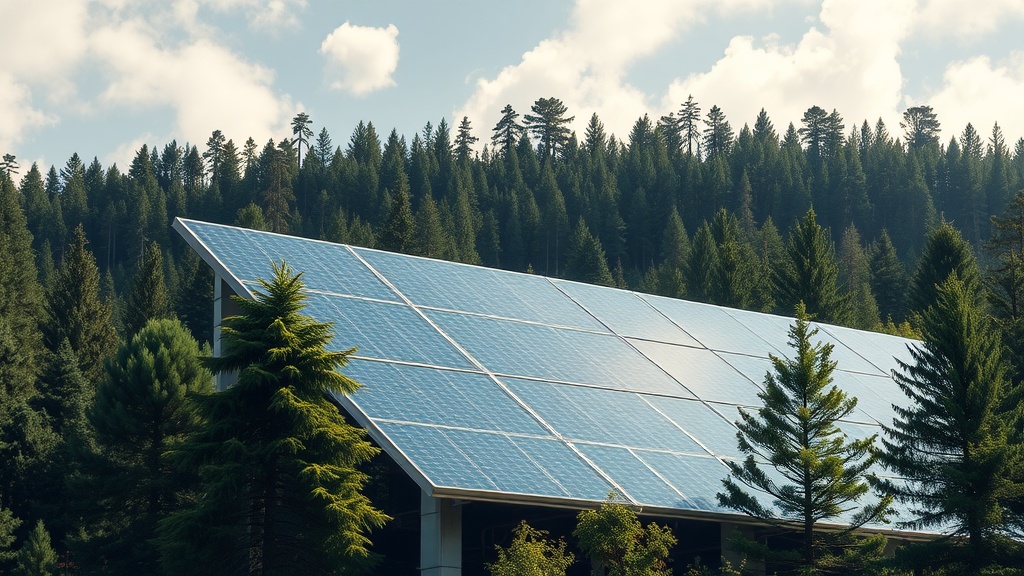Physical Address
304 North Cardinal St.
Dorchester Center, MA 02124
Physical Address
304 North Cardinal St.
Dorchester Center, MA 02124

When considering solar panel installations in forested areas, understanding the unique challenges and opportunities becomes crucial for maximizing energy production. Sunlight penetration through forest canopies significantly impacts the potential effectiveness of solar technology in these environments.
Solar panels require consistent and direct sunlight to generate optimal electricity. Forests present complex light transmission scenarios where tree density, height, and seasonal variations dramatically influence solar potential. Dense tree coverage can reduce direct sunlight exposure, potentially limiting panel efficiency by 30-50% compared to open landscape installations.
Check out one of the industry leading solar panel kits here
Several critical elements determine solar panel performance in forested regions:
• Tree species composition
• Canopy height and density
• Geographic location
• Seasonal leaf coverage
• Angle of sunlight penetration
Careful positioning becomes paramount when installing solar panels within forest environments. Professionals recommend:
Check out one of the top rated solar panel kits here – https://www.healthrefreshed.com/solar-panel-kits
Precise light transmission measurements help determine solar viability. Advanced technologies like LiDAR scanning enable comprehensive forest canopy assessments, providing detailed insights into potential solar energy generation.
| Forest Density | Light Transmission | Estimated Solar Efficiency |
|---|---|---|
| Low Density | 60-70% | 85-90% |
| Medium Density | 40-50% | 65-75% |
| High Density | 20-30% | 40-55% |
Modern solar panel technologies offer innovative solutions for challenging forest environments:
• Bifacial panels capturing reflected light
• High-efficiency photovoltaic cells
• Adaptive tracking systems
While forest environments present challenges, they also offer unique opportunities for sustainable energy generation. Careful planning, advanced technologies, and professional assessments can transform seemingly unsuitable locations into viable solar sites.
Check out one of the top rated solar panel kits here – https://www.healthrefreshed.com/solar-panel-kits
Property owners and renewable energy developers must collaborate with forestry experts and solar technicians to maximize potential energy production. Understanding micro-climate variations, seasonal changes, and precise light transmission dynamics becomes essential for successful implementations.
By applying scientific methodologies and leveraging cutting-edge technologies, solar installations in forested regions can overcome traditional limitations, transforming challenging environments into sustainable energy generation sites.
When exploring the potential of solar panel installations within forested environments, understanding light penetration becomes crucial for photovoltaic performance. The complex interaction between tree canopies and solar energy generation presents unique challenges and opportunities for renewable energy strategies.
Trees naturally create multilayered light filtering systems that significantly impact solar radiation transmission. Different forest types – deciduous, coniferous, and mixed forests – demonstrate varying light penetration characteristics affecting solar panel efficiency.
Research indicates that forest environments typically reduce direct sunlight by 60-90%, creating challenging conditions for traditional solar panel installations. However, strategic placement and advanced panel technologies can mitigate these limitations.
Check out one of the industry leading solar panel kits here
Innovative approaches have emerged to optimize photovoltaic performance within forest settings:
Modern solar panels engineered with multi-junction cells and enhanced light-capturing capabilities can generate electricity even under partial shade conditions. These specialized panels utilize:
| Forest Type | Light Transmission | Solar Potential |
|---|---|---|
| Deciduous | 40-60% | Moderate |
| Coniferous | 20-40% | Low |
| Mixed Forest | 30-50% | Variable |
Geographical considerations play a significant role in determining solar feasibility. Regions with less dense forest coverage and more open canopy structures present more favorable conditions for solar panel installations.
Sustainable solar integration requires comprehensive environmental evaluations. Researchers recommend:
Expert collaborations between forest ecologists, solar engineers, and environmental scientists can develop nuanced approaches to harmonizing renewable energy generation with forest ecosystem preservation.
National Renewable Energy Laboratory
U.S. Department of Energy Solar Resources
Fraunhofer Institute for Solar Energy Systems
Economic feasibility remains contingent upon precise site-specific assessments. Investors and renewable energy developers must conduct thorough site surveys, analyzing light penetration, vegetation density, and seasonal solar radiation patterns.
Emerging technologies continue expanding possibilities for solar energy generation within forested landscapes, promising more sophisticated and environmentally conscious solutions for sustainable power production.
Solar energy potential in forested areas presents a nuanced landscape of challenges and opportunities. While tree canopies traditionally pose limitations for solar panel efficiency, innovative strategies and technological advancements are reshaping our understanding of photovoltaic performance in woodland settings.
The key takeaway is that forests aren’t necessarily a dealbreaker for solar installations. Strategic panel placement, selective tree trimming, and advanced solar technologies can mitigate light penetration issues. Panels positioned in forest clearings or along forest edges can still generate substantial electricity, proving that woodland environments aren’t automatically unsuitable for solar energy production.
Emerging research suggests that contextual factors like tree density, canopy height, and seasonal variations significantly impact solar potential. Landowners and renewable energy developers should conduct comprehensive site assessments to evaluate specific solar feasibility. Utilizing specialized light detection tools and solar modeling software can provide precise insights into potential energy generation.
Check out one of the top rated solar panel kits here – https://www.healthrefreshed.com/solar-panel-kits
Modern solar panels with enhanced low-light performance and improved efficiency technologies are increasingly capable of harvesting energy under partial shade conditions. This technological evolution means forests are no longer absolute barriers to solar power generation.
Sustainable energy strategies must consider local ecosystem characteristics. While complete forest clearing isn’t recommended, carefully planned solar installations can coexist with natural woodland environments. The goal is finding a balanced approach that respects ecological integrity while maximizing renewable energy potential.
Future innovations in solar panel design and forest management techniques will continue expanding our ability to generate clean energy in diverse landscape configurations. Continued research and adaptive technologies will be crucial in transforming seemingly challenging environments into viable solar energy resources.